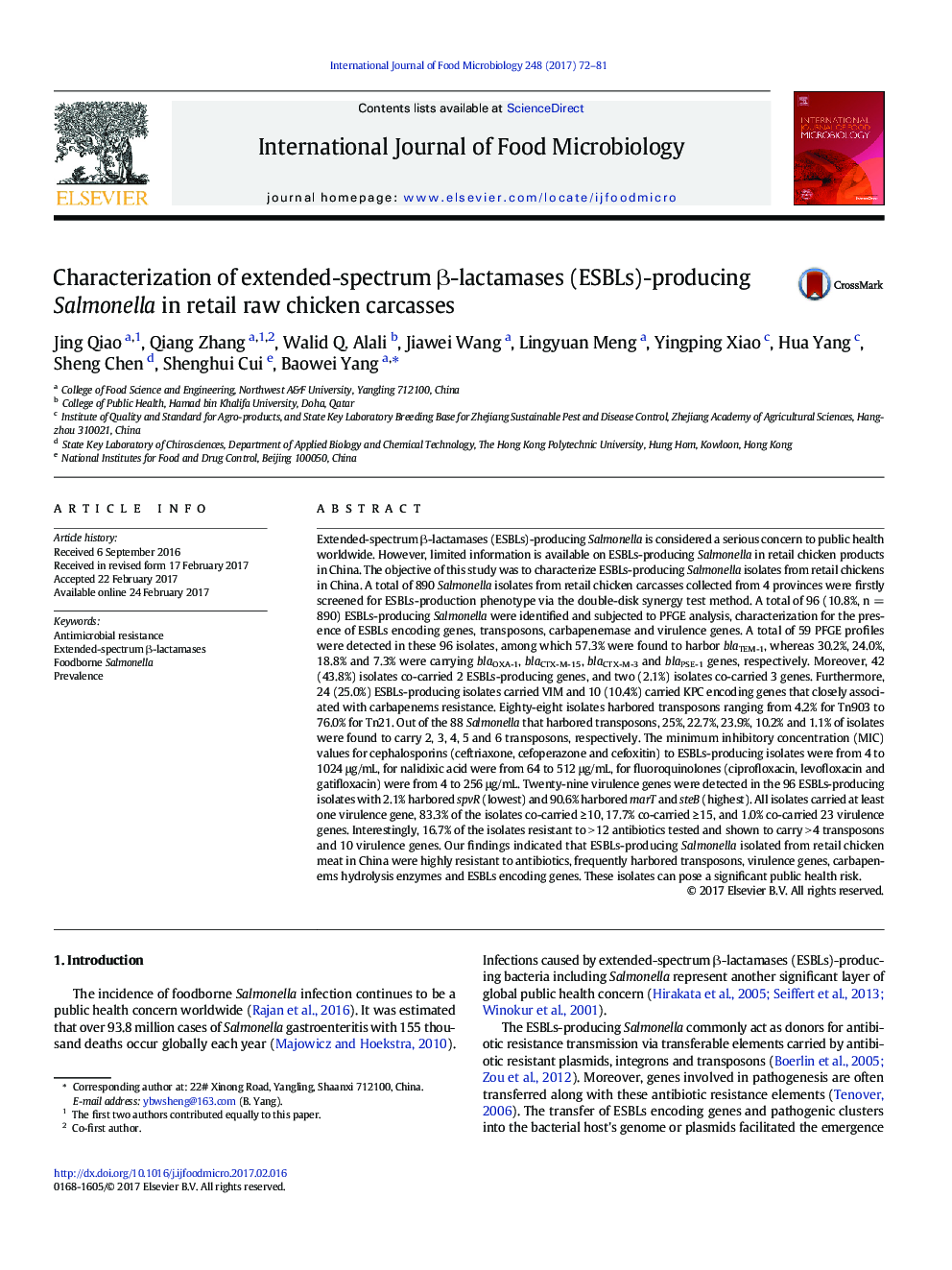| کد مقاله | کد نشریه | سال انتشار | مقاله انگلیسی | نسخه تمام متن |
|---|---|---|---|---|
| 5740791 | 1616535 | 2017 | 10 صفحه PDF | دانلود رایگان |

- 96 ESBLs-producing isolates were identified and subtyped via PFGE.
- blaTEM-1, blaOXA-1, blaCTX-M-15, blaCTX-M-3 and blaPSE-1 were detected.
- Transposons, carbapenems-resistance related genes and virulence genes were identified.
- ESBLs-producing isolates showed strong resistance to cephalosporins and floroquinolones.
- ESBLs-producing isolates co-carried at least 10 virulence genes, â¥Â 4 transposons and co-resisted to â¥Â 12 antibiotics.
Extended-spectrum β-lactamases (ESBLs)-producing Salmonella is considered a serious concern to public health worldwide. However, limited information is available on ESBLs-producing Salmonella in retail chicken products in China. The objective of this study was to characterize ESBLs-producing Salmonella isolates from retail chickens in China. A total of 890 Salmonella isolates from retail chicken carcasses collected from 4 provinces were firstly screened for ESBLs-production phenotype via the double-disk synergy test method. A total of 96 (10.8%, n = 890) ESBLs-producing Salmonella were identified and subjected to PFGE analysis, characterization for the presence of ESBLs encoding genes, transposons, carbapenemase and virulence genes. A total of 59 PFGE profiles were detected in these 96 isolates, among which 57.3% were found to harbor blaTEM-1, whereas 30.2%, 24.0%, 18.8% and 7.3% were carrying blaOXA-1, blaCTX-M-15, blaCTX-M-3 and blaPSE-1 genes, respectively. Moreover, 42 (43.8%) isolates co-carried 2 ESBLs-producing genes, and two (2.1%) isolates co-carried 3 genes. Furthermore, 24 (25.0%) ESBLs-producing isolates carried VIM and 10 (10.4%) carried KPC encoding genes that closely associated with carbapenems resistance. Eighty-eight isolates harbored transposons ranging from 4.2% for Tn903 to 76.0% for Tn21. Out of the 88 Salmonella that harbored transposons, 25%, 22.7%, 23.9%, 10.2% and 1.1% of isolates were found to carry 2, 3, 4, 5 and 6 transposons, respectively. The minimum inhibitory concentration (MIC) values for cephalosporins (ceftriaxone, cefoperazone and cefoxitin) to ESBLs-producing isolates were from 4 to 1024 μg/mL, for nalidixic acid were from 64 to 512 μg/mL, for fluoroquinolones (ciprofloxacin, levofloxacin and gatifloxacin) were from 4 to 256 μg/mL. Twenty-nine virulence genes were detected in the 96 ESBLs-producing isolates with 2.1% harbored spvR (lowest) and 90.6% harbored marT and steB (highest). All isolates carried at least one virulence gene, 83.3% of the isolates co-carried â¥Â 10, 17.7% co-carried â¥Â 15, and 1.0% co-carried 23 virulence genes. Interestingly, 16.7% of the isolates resistant to > 12 antibiotics tested and shown to carry > 4 transposons and 10 virulence genes. Our findings indicated that ESBLs-producing Salmonella isolated from retail chicken meat in China were highly resistant to antibiotics, frequently harbored transposons, virulence genes, carbapenems hydrolysis enzymes and ESBLs encoding genes. These isolates can pose a significant public health risk.
150
Journal: International Journal of Food Microbiology - Volume 248, 2 May 2017, Pages 72-81